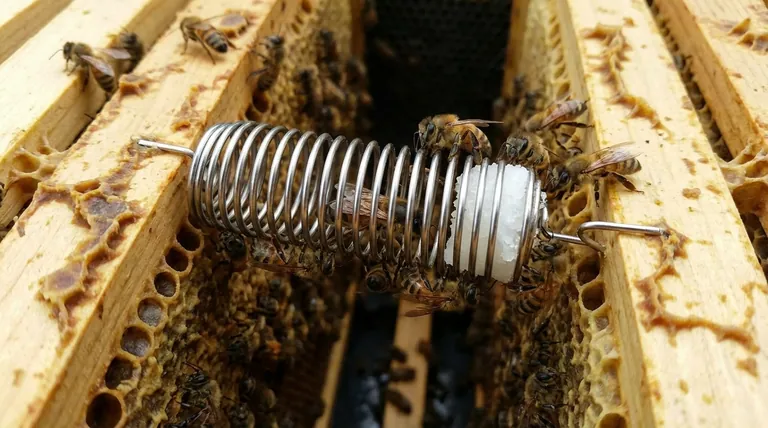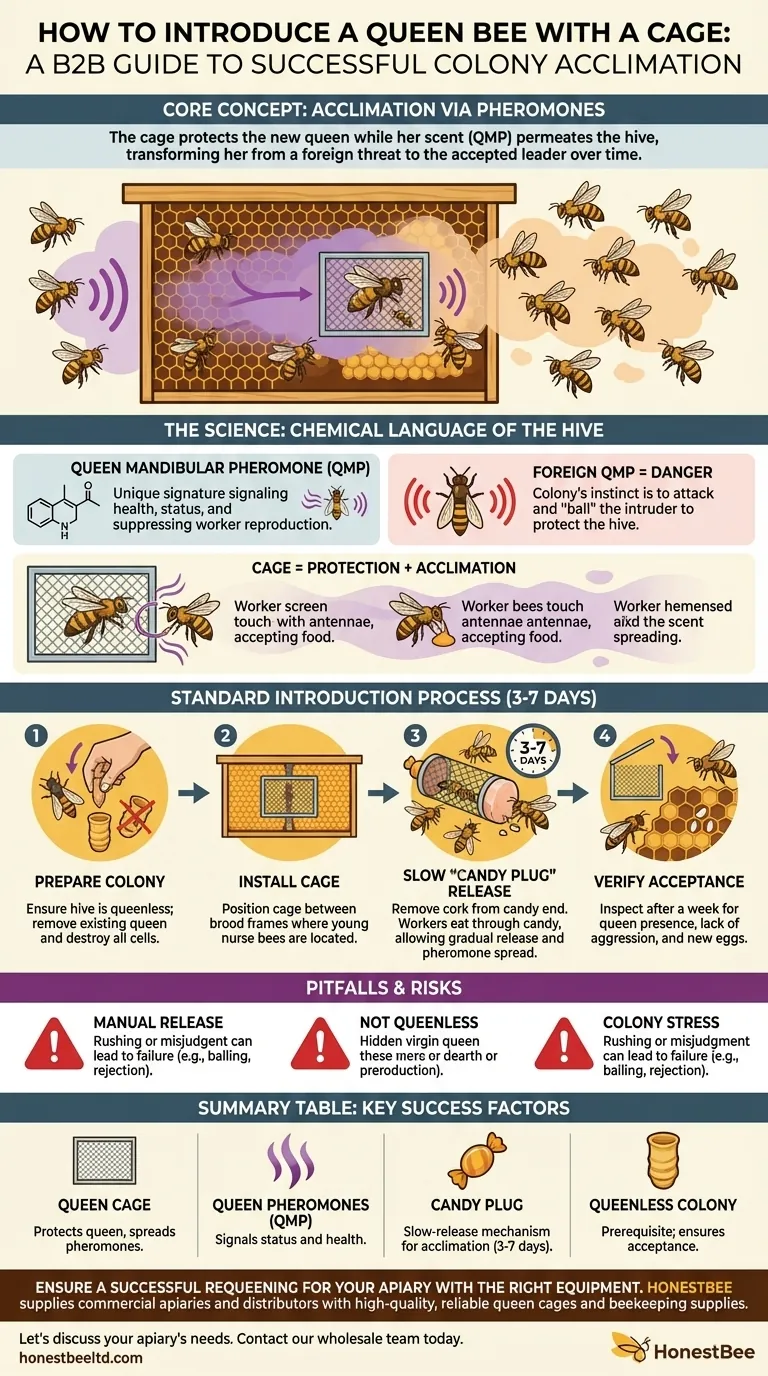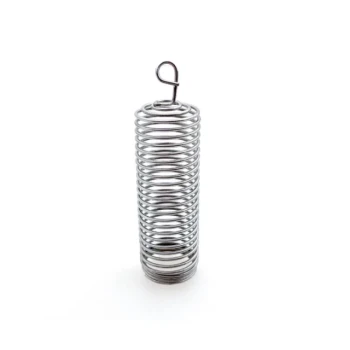At its core, introducing a queen bee is a carefully managed process of acclimation. A new queen is placed within a small cage inside the hive, which protects her from the worker bees who initially see her as a foreign threat. This cage allows her unique scent—her pheromones—to spread throughout the colony, gradually convincing the hive that she is their new leader before she is slowly released.
The fundamental challenge is overcoming a colony's natural instinct to kill a foreign queen. The queen cage acts as a crucial tool for social integration, using time and scent to transform the queen from an intruder into the accepted mother of the hive.

The Science of Queen Acceptance
To successfully introduce a queen, you must understand the chemical language of the hive. The entire process hinges on managing the colony's response to the queen's unique pheromones.
The Role of Queen Pheromones
A queen bee produces a complex chemical cocktail known as Queen Mandibular Pheromone (QMP). This scent is her signature, signaling her presence, health, and reproductive status to every bee in the colony.
QMP is the social glue of the hive. It suppresses worker bee ovary development and lets the colony know it has a viable, laying queen.
Why a New Queen Is a Threat
When a new queen is introduced, her QMP is foreign. The colony's worker bees, loyal to their previous queen's scent (or the memory of it), perceive this new bee as a dangerous invader.
Their immediate instinct is to protect the colony by surrounding and killing the intruder, a process known as "balling."
How the Cage Facilitates Acclimation
The queen cage is a simple but brilliant tool. Its mesh screen acts as a physical barrier, protecting the queen from attack.
Simultaneously, the screen allows the workers to get close. They can touch her with their antennae, feed her, and most importantly, become accustomed to her specific QMP. Over several days, her scent permeates the hive and slowly overwrites the old one.
The Standard Introduction Process
While methods vary slightly, the following steps represent the most reliable and widely used technique for ensuring a successful introduction.
Step 1: Prepare the Colony
Before introducing a new queen, you must be certain the colony is queenless. A hive will not accept a new queen if it already has one, or if it is in the process of raising its own from queen cells.
Inspect the frames carefully and remove any existing queen or destroy all queen cells you find. A hopelessly queenless colony is far more receptive.
Step 2: Install the Queen Cage
The new queen typically arrives in a small wooden or plastic cage with a few attendant bees. One end of the cage is blocked by a small cork, while the other is plugged with a hard sugar candy.
Position the cage between two frames of brood in the center of the hive. The brood area has the highest concentration of young nurse bees, who are generally more accepting of a new queen.
Step 3: The Slow "Candy Plug" Release
Remove the cork from the candy end of the cage, not the empty end. This exposes the sugar candy to the hive's worker bees.
The workers will begin to eat the candy to free the queen. This process takes 3 to 7 days, providing the perfect amount of time for the colony to fully acclimate to her pheromones before she can walk free. This slow release is the key to success.
Step 4: Verify Acceptance
After about a week, perform a quick, quiet inspection. Look for the opened queen cage and evidence of the new queen. You may see her walking calmly on the frame, with worker bees tending to her rather than showing aggression.
Ideally, you will also see new eggs—tiny, rice-shaped specks at the bottom of cells—which is definitive proof that she has been accepted and has begun her work.
Understanding the Pitfalls and Risks
Queen introduction is a delicate operation where rushing or misjudgment can lead to failure. Understanding the common mistakes is crucial for prevention.
The Danger of a Manual Release
Manually releasing the queen by opening the cage yourself is extremely risky. It bypasses the critical acclimation period the candy plug provides.
Unless you are an experienced beekeeper who can accurately read the colony's behavior, this often results in the workers immediately balling and killing the queen you just introduced.
Failure to Confirm the Hive is Queenless
The most common reason for rejection is the presence of an existing queen. This could be the old queen you thought you removed or, more deceptively, a small, hard-to-spot virgin queen that emerged from a hidden swarm cell.
If another queen is present, the new queen will be killed. Always double-check for queen cells and be certain of the colony's status.
Colony Stress and Temperament
A colony under stress is less likely to accept a new queen. Factors like a lack of nectar, pest pressure from varroa mites, or an aggressive temperament can make the bees defensive and unreceptive.
In these situations, it is wise to leave the queen caged for a longer period to ensure acceptance before allowing the release.
Making the Right Choice for Your Hive
Your specific approach should be guided by the state of your colony.
- If your hive is confirmed queenless (e.g., after a swarm): The standard candy plug method is your most reliable path. Install the cage and let the bees manage the release over 3-7 days.
- If you are replacing an old or failing queen: Remove the old queen and wait 24 hours before introducing the new caged queen. This waiting period helps the colony fully recognize its queenless state.
- If your colony is defensive or stressed: Be extra patient. You can leave the cork in the candy end for 2-3 days before removing it, giving the pheromones even more time to spread before the release process begins.
Ultimately, successful requeening is achieved through a patient understanding of bee biology, not through force or haste.
Summary Table:
| Key Factor | Role in Successful Introduction |
|---|---|
| Queen Cage | Protects the queen while allowing her pheromones to spread through the hive. |
| Queen Pheromones (QMP) | The queen's unique scent that signals her status and health to the colony. |
| Candy Plug | A slow-release mechanism that gives the colony 3-7 days to acclimate before the queen is freed. |
| Queenless Colony | A prerequisite; a hive with an existing queen or queen cells will reject the new queen. |
Ensure a successful requeening for your apiary with the right equipment.
A smooth queen introduction is critical for maintaining strong, productive colonies. HONESTBEE supplies commercial apiaries and beekeeping equipment distributors with high-quality, reliable queen cages and other essential beekeeping supplies through our wholesale-focused operations. We provide the tools you need to manage your hives effectively and maximize honey production.
Let's discuss your apiary's needs. Contact our wholesale team today to get the right supplies for your operation.
Visual Guide

Related Products
- Durable Galvanized Steel Spring Queen Bee Cage
- Professional Queen Cage with Sliding Gate and Feeder Plug
- Professional Round Push-In Queen Cage with Metal Tines
- Wood and Mesh Push-In Queen Cage
- No Grafting Queen Rearing Kit: System for Royal Jelly Production and Queen Rearing
People Also Ask
- How long does it typically take bees to adjust to a new queen? Master the 2-7 Day Acceptance Window
- When are queen cages typically used in beekeeping? Ensure a Successful Queen Introduction
- What should you do if the queen is still in the cage and the worker bees have not accepted her? Protect Your Colony from Queen Rejection
- How should a queen cage be maintained over time? Ensure Queen Introduction Success
- How should you remove the queen cage from the hive? Ensure a Successful Queen Introduction



















